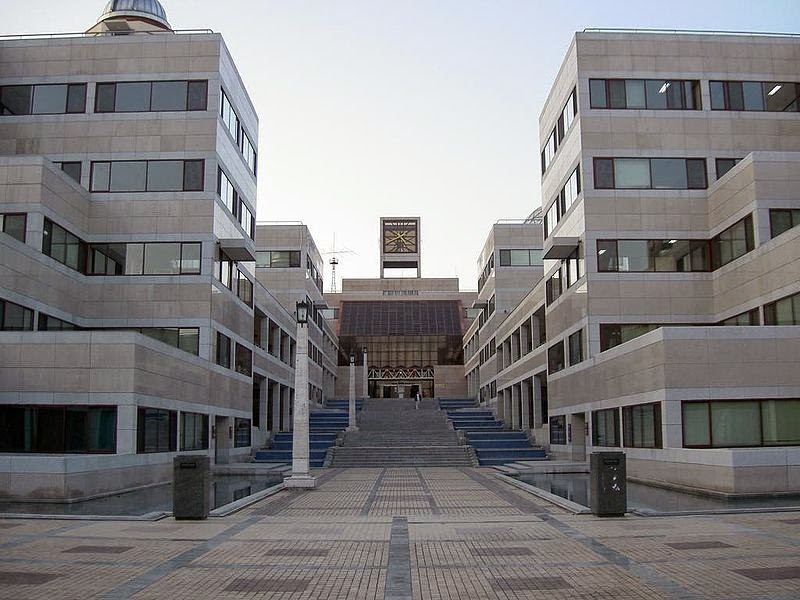National University of Singapore (NUS)
.JPG) The climb of Singapore’s flagship establishment from second to 1st place are some things of a landmark moment, each for Singapore and for the region additional wide. this can be the primary time since the QS University Rankings: Asia was launched in 2009 that the ranking has been flat-topped by a university outside of Hong Kong. furthermore as rising within the regional ranking, the National University of Singapore (NUS) has additionally been steady rising its performance on the international stage; as of the 2013/14 QS World University Rankings®, it ranks among the worldwide high twenty five. It’s the top-rated university in Asia consistent with surveyed employers, and comes second within the international survey of lecturers, behind the University of Japanese capital.
The climb of Singapore’s flagship establishment from second to 1st place are some things of a landmark moment, each for Singapore and for the region additional wide. this can be the primary time since the QS University Rankings: Asia was launched in 2009 that the ranking has been flat-topped by a university outside of Hong Kong. furthermore as rising within the regional ranking, the National University of Singapore (NUS) has additionally been steady rising its performance on the international stage; as of the 2013/14 QS World University Rankings®, it ranks among the worldwide high twenty five. It’s the top-rated university in Asia consistent with surveyed employers, and comes second within the international survey of lecturers, behind the University of Japanese capital.KAIST – Korea Advanced Institute of Science and Technology

South Korea’s KAIST has created a powerful leap this year, from sixth to second place within the Asian university rankings. one in all variety of comparatively young universities in Asia that have apace established a powerful international standing, this specialised public establishment came third within the 2013 edition of the QS high fifty beneath fifty, that highlights the world’s leading establishments established among the second half century. KAIST’s rise within the QS University Rankings: Asia is essentially attributable to strong scores within the indicators assessing analysis production and impact, reflective the institution’s growth into a serious research facility.
University of Hong Kong (HKU)
.JPG) A former table-topper, the University of Hong Kong (HKU) slips one place this year to 3rd, following a wider trend of slight loss of ground within the Asian university rankings for universities in Hong Kong. This loss is a minimum of part explained by the region’s recent amendment from a three-year to four-year college man degree system, that has semiconductor diode to poorer faculty: student ratios. Overall, however, universities in Hong Kong stay among the strongest in Asia across all 9 assessment indicators accustomed compile the ranking, and notably those centered on group action. Indeed, the University of Hong Kong retains the best proportion of international students among high universities in Asia.
A former table-topper, the University of Hong Kong (HKU) slips one place this year to 3rd, following a wider trend of slight loss of ground within the Asian university rankings for universities in Hong Kong. This loss is a minimum of part explained by the region’s recent amendment from a three-year to four-year college man degree system, that has semiconductor diode to poorer faculty: student ratios. Overall, however, universities in Hong Kong stay among the strongest in Asia across all 9 assessment indicators accustomed compile the ranking, and notably those centered on group action. Indeed, the University of Hong Kong retains the best proportion of international students among high universities in Asia.Seoul National University (SNU)
.jpg) The second entry from Asian nation, national capital National University (SNU) holds onto fourth position, having been overtaken by subject KAIST. It retains sturdy scores across the board, and remains South Korea’s highest rated university within the international educational survey. each SNU and KAIST square measure a part of a wider upwards trend in South Korean teaching, that has undergone dramatic transformation in a very comparatively short house of your time. This year, seventieth of the highest twenty universities in Asian nation have either improved or maintained their positions within the QS University Rankings: Asia.
The second entry from Asian nation, national capital National University (SNU) holds onto fourth position, having been overtaken by subject KAIST. It retains sturdy scores across the board, and remains South Korea’s highest rated university within the international educational survey. each SNU and KAIST square measure a part of a wider upwards trend in South Korean teaching, that has undergone dramatic transformation in a very comparatively short house of your time. This year, seventieth of the highest twenty universities in Asian nation have either improved or maintained their positions within the QS University Rankings: Asia.Hong Kong University of Science and Technology (HK
Having headed the ranking last year, the Hong Kong University of Science and Technology (HKUST) currently finds itself in fifth place. Like different universities in Hong Kong, it suffers from a poorer faculty: student quantitative relation this year, following the ‘double cohort’ impact ensuing from the switch from three-year to four-year programs, however overall still remains one in all the region’s overall high performers. Like different universities in Hong Kong, HKUST scores notably well within the group action indicators; it’s crushed solely by HKU for proportion of international students. hierarchal thirty fourth within the world, consistent with the 2013/14 QS World University Rankings, it claimed 1st place within the 2013 QS high fifty beneath fifty
The Chinese University of Hong Kong (CUHK)
Going against the general trend among leading universities in Hong Kong, the Chinese University of Hong Kong (CUHK) improves its position within the Asian university rankings by one this year. Like its neighbors, CUHK enjoys particularly sturdy scores for the international diversity of each educational workers and students. It additionally boasts one in all the strongest international reputations among universities in Asia, connection HKU and HKUST within the high ten universities in Asia supported QS’s international survey of lecturers.
Nanyang Technological University (NTU)
.jpg) Proving that NUS isn't the sole star within the Singaporean system, Nanyang Technological University (NTU) consolidates its place among the highest universities in Asia this year, rising 3 places. Another fast-developer, established solely in 1981, NTU came third within the last edition of the QS high fifty beneath fifty, with associate degree overall international ranking of forty first. simply outside the highest ten Asian establishments as rated by lecturers, it comes fifth within the region supported the international survey of employers. It additionally has the third strongest score for proportion of international students, simply beating NUS on this live
Proving that NUS isn't the sole star within the Singaporean system, Nanyang Technological University (NTU) consolidates its place among the highest universities in Asia this year, rising 3 places. Another fast-developer, established solely in 1981, NTU came third within the last edition of the QS high fifty beneath fifty, with associate degree overall international ranking of forty first. simply outside the highest ten Asian establishments as rated by lecturers, it comes fifth within the region supported the international survey of employers. It additionally has the third strongest score for proportion of international students, simply beating NUS on this livePohang University of Science and Technology (POSTECH)
.jpg) The third South Korean university to rank among the ten high universities in Asia, POSTECH is that the country’s second major science and technology specialist – the private-sector counterpart to public establishment KAIST. POSTECH improves its position by 2 places this year, claiming notably sturdy scores each for analysis impact and for educational staffing levels. It ranks fifth among high universities in Asia within the analysis citations indicator; among the general high ten listed here, solely NUS fares higher. It additionally has far and away the most effective faculty: student quantitative relation among thesetop ten establishments, ranking fourth in Asia on this live.
The third South Korean university to rank among the ten high universities in Asia, POSTECH is that the country’s second major science and technology specialist – the private-sector counterpart to public establishment KAIST. POSTECH improves its position by 2 places this year, claiming notably sturdy scores each for analysis impact and for educational staffing levels. It ranks fifth among high universities in Asia within the analysis citations indicator; among the general high ten listed here, solely NUS fares higher. It additionally has far and away the most effective faculty: student quantitative relation among thesetop ten establishments, ranking fourth in Asia on this live.University of Japanese capital

Finally, Japan’s University of Japanese capital completes the list, slippery one place this year however holding onto its top-10 spot. whereas several of Japan’s leading universities have seen their positions fall this year, the University of Japanese capital remains the top-rated Asian establishment consistent with surveyed lecturers, and second consistent with graduate employers (behind NUS). Its weakest scores square measure within the group action indicators, and this reflects a wider challenge for universities in Japan, that have usually not been as no-hit as different high universities in Asia once it involves attracting students and lecturers from different countries.
.jpg)
.JPG)


